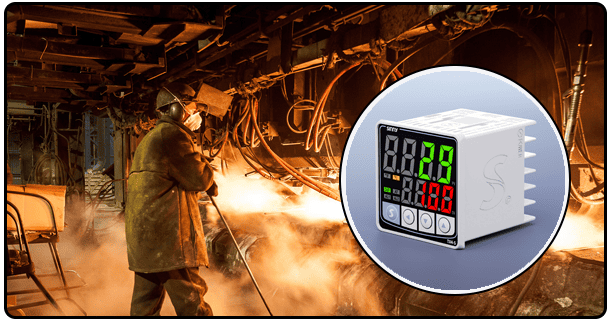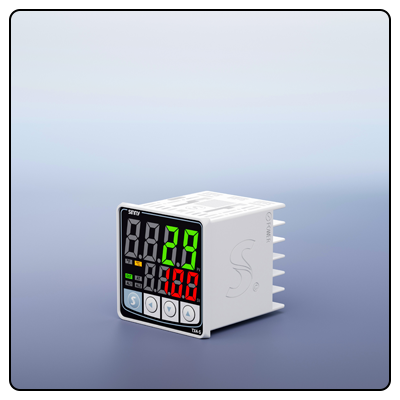What is a PID Temperature Controller? Comprehensive Guide
Learn what a PID temperature controller is and how it works. Discover its components, working principles, advantages, applications, and challenges in this comprehensive guide.
1. Introduction
A PID temperature controller is an advanced piece of machinery used to keep desired temperatures at a stable, accurate level through using an internal control loop feedback mechanism. PID stands for Proportional-Integral-Derivative; three key actions used to provide precise yet stable temperature management. These controllers play an essential part in industrial processes as well as scientific research where precise control is key to efficiency and quality outcomes.
2. Components of a PID Temperature Controller
PID temperature controller systems typically consist of three main components.
Sensors:
Sensors measure current temperature and provide feedback to controllers, with thermocouples and Resistance Temperature Detectors (RTDs) among the more popular choices; thermocouples typically offer fast temperature-to-response times while RTDs boast greater precision and stability.
Controller Unit:
At the heart of every system lies its controller unit, where PID algorithm implementation takes place. Sensor data are processed through this controller unit before any necessary adjustments to maintain setpoint temperature are calculated - modern digital controllers often offer advanced features such as programmability, data logging and remote monitoring to further facilitate temperature regulation.
Control Elements:
Control elements refers to devices which adjust temperature directly, such as heaters, coolers or valves. A controller sends signals to these elements which increase or decrease as necessary.
3. How PID Temperature Controllers Work
PID temperature controllers employ three distinct control actions in order to provide precise temperature regulation:
Proportional Control:
Proportional control adjusts output power proportionally to any difference between setpoint temperature and actual temperature, or current temperature, and its output power consumption. As temperatures near their setpoints, corrections decrease gradually as their respective temperatures get closer, thus decreasing any chance for overshooting.
Integral Control:
This action addresses any cumulative errors over time. For instance, if temperature falls consistently below the setpoint, integral action will increase output until all steady-state errors have been eliminated to help ensure temperature reaches and remains within its target parameters.
darui Derivative Control:
Derivative control predicts future temperature changes by looking at their rate of change, taking into account how quickly temperatures approach setpoint and applying corrective actions as soon as necessary to prevent overshooting or oscillations and ensure more stable, responsive control system performance.
Adjusting a PID Controller:
Tuning a PID controller involves setting its proportional, integral and derivative gains for optimal performance - either manually through trial and error or using software tools that automate this process. Proper tuning ensures responsiveness without excessive oscillations for best performance in response to change.
4. How PID Temperature Controllers Work
PID temperature controllers offer several advantages over simpler methods for temperature regulation:
Precision and Stability:
PID controllers offer highly precise temperature regulation by combining proportional, integral, and derivative actions - essential when slight temperature variations could negatively impact product quality or process efficiency.
Versatility Across Applications:
PID controllers can be applied across many industries and consumer goods applications ranging from industrial processes to consumer products, handling complex control tasks while adapting to varied system dynamics.
Energy Efficiency:
PID controllers maximize energy usage through precise control. By eliminating frequent on/off cycling that wastes energy and wears on control elements, PID controllers help optimize their usage efficiently and lower operating costs overall.Tuning the PID Controller: Tuning a PID controller involves setting the proportional, integral, and derivative gains to achieve optimal performance. This can be done manually through trial and error or using software tools that automate the process. Proper tuning is essential for balancing responsiveness and stability, ensuring the system reacts appropriately to changes without excessive oscillations.
5. PID Temperature Controller Applications
Temperature control via PID temperature controllers has many practical uses, including:
Industrial Processes:
PID controllers ensure smooth operations in industries such as chemical manufacturing, food processing and pharmaceutical production, where temperature control plays an integral part in both product quality and process efficiency. They help keep processes operating reliably over the entire production run cycle.
HVA Systems:
Heating, ventilation and air conditioning systems use PID controllers to create comfortable yet energy efficient indoor environments by adjusting heating and cooling outputs according to desired setpoint temperatures.
Scientific Research and Laboratory Equipment:
Laboratories and research facilities depend heavily on PID controllers to maintain specific environments during experiments, with accurate temperature regulation being key in producing reproducible results and maintaining scientific studies with integrity.
6. Challenges and Considerations
As PID temperature controllers can provide many advantages, there may be certain challenges and considerations you should keep in mind before investing. Here are a few important ones.
Wrangling PID Controller Set-Up and Tuning:
Conceivably, setting up and tuning a PID controller may be complex and time consuming process that demands knowledge of system dynamics and control processes, in addition to an understanding of PID control processes themselves. Failure to get this right may result in subpar performance or instability issues for your PID system.
Maintenance and Calibration:
Routine maintenance and calibration are necessary to maintain the accuracy and reliability of PID controllers, since sensors and control elements may drift over time and affect its performance negatively
Cost Considerations:
PID controllers tend to be more costly than their simpler control methods, yet their benefits in terms of precise precision, stability and energy efficiency often outweigh this expense in crucial applications.
7. Conclusions
PID temperature controllers are essential tools for achieving precise and stable temperature control in various applications. By combining proportional, integral, and derivative actions, they provide accurate and responsive control, ensuring optimal performance and efficiency. Despite the challenges of setup and maintenance, the advantages of using PID controllers make them a valuable asset in industrial processes, HVAC systems, and scientific research.
- Understanding PID in Temperature Controllers: Proportional, Integral, Derivative
- What is a Temperature Controller and How Does It Work?;Comprehensive Guide























